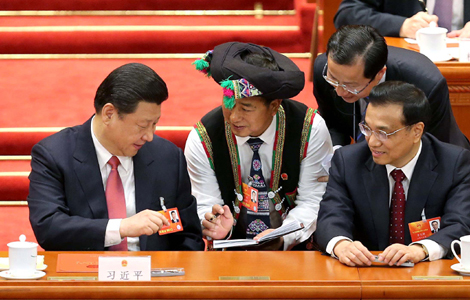China to control megacities' size in urbanization
Updated: 2013-03-09 08:44BEIJING -- Grey smog returned to Beijing again over the past two days and forced residents to wear masks outdoors. Polluting weather has hit the Chinese capital frequently since the beginning of the year.
A key factor leading to the smog is exhaust from vehicles.
About 5.2 million vehicles are running on the roads in the metropolis, which has a population of 20.6 million.
Traffic congestion and shortage of resources, such as water, are also common problems for other large cities in China.
On Tuesday, delivering a government work report to the first session of the 12th National People's Congress, the Parliament, Premier Wen Jiabao said megacities and large cities should be kept to an appropriate size and they should fully play their role in driving the development of surrounding areas.
The following day, Zhang Ping, head of the National Development and Reform Commission, said the country should appropriately control the expansion of mega and large cities, and exert efforts to develop small and medium-sized cities and small towns.
China is likely to draw a layout on the country's urbanization drive in the first half of the year, he added.
By the end of 2012, the country's urbanization level rose to 52.6 percent from 45.9 percent five years ago, marking a historic turning point in the nation's urban-rural population structure. The figure means more than half of the total population live in cities.
In China, a megacity refers to one with a population of 10 million or above and a large city five million or more, according to Pan Jiahua, head of the Urban and Environmental Studies Institute at the Chinese Academy of Social Sciences (CASS).
Currently, Beijing, Shanghai and Chongqing municipalities all have a population of more than 20 million. Cities like Tianjin, Guangzhou and Shenzhen have a population of more than 10 million.
The country is planning to promote sound urbanization development in an active yet prudent way. Authorities believe urbanization offers the largest potential for China to expand domestic demand, which is vital for sustainable growth of the world's second largest economy.


